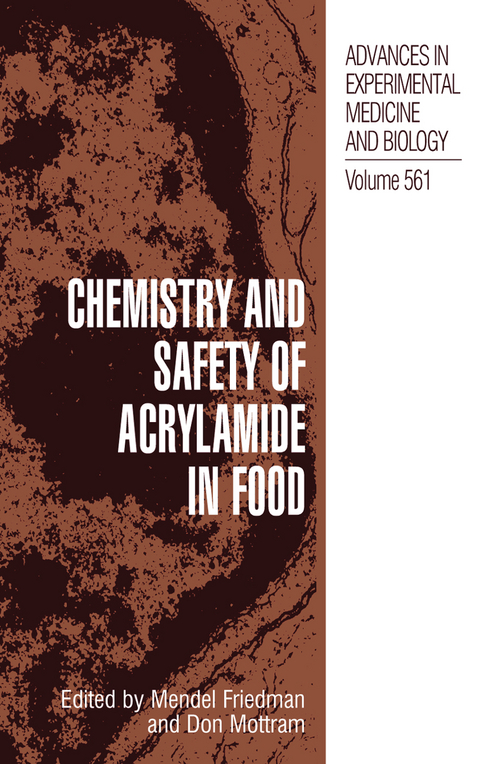
Chemistry and Safety of Acrylamide in Food
Springer-Verlag New York Inc.
978-0-387-23920-0 (ISBN)
Reports that heat processing of foods induces the formation of acrylamide heightened interest in the chemistry, biochemistry, and safety of this compound. Acrylamide-induced neurotoxicity, reproductive toxicity, genotoxicity, and carcinogenicity are potential human health risks based on animal studies. Because exposure of humans to acrylamide can come from both external sources and the diet, there exists a need to develop a better understanding of its formation and distribution in food and its role in human health. To contribute to this effort, experts from eight countries have presented data on the chemistry, analysis, metabolism, pharmacology, and toxicology of acrylamide.
Specifically covered are the following aspects: exposure from the environment and the diet; biomarkers of exposure; risk assessment; epidemiology; mechanism of formation in food; biological alkylation of amino acids, peptides, proteins, and DNA by acrylamide and its epoxide metabolite glycidamide; neurotoxicity, reproductive toxicity, and carcinogenicity; protection against adverse effects; and possible approaches to reducing levels in food. Cross-fertilization of ideas among several disciplines in which an interest in acrylamide has developed, including food science, pharmacology, toxicology, and medicine, will provide a better understanding of the chemistry and biology of acrylamide in food, and can lead to the development of food processes to decrease the acrylamide content of the diet.
Acrylamide in Food: The Discovery and Its Implications.- Acrylamide Neurotoxicity: Neurological, Morhological and Molecular Endpoints in Animal Models.- The Role of Epidemiology in Understanding the Relationship between Dietary Acrylamide and Cancer Risk in Humans.- Mechanisms of Acrylamide Induced Rodent Carcinogenesis.- Exposure to Acrylamide.- Acrylamide and Glycidamide: Approach towards Risk Assessment Based on Biomarker Guided Dosimetry of Genotoxic/Mutagenic Effects in Human Blood.- Pilot Study on the Impact of Potato Chips Consumption on Biomarkers of Acrylamide Exposure.- LC/MS/MS Method for the Analysis of Acrylamide and Glycidamide Hemoglobin Adducts.- Comparison of Acrylamide Metabolism in Humans and Rodents.- Kinetic and Mechanistic Data Needs for a Human Phsiologically Based Pharmacokinetic (PBPK) Model for Acrylamide.- In Vitro Studies of the Influence of Certain Enzymes on the Detoxification of Acrylamide and Glycidamide in Blood.- Biological Effects of Maillard Browning Products That May Affect Acrylamide Safety in Food.- Acrylamide Formation in Different Foods and Potential Strategies for Reduction.- Mechanisms of Acrylamide Formation.- Mechanistic Pathways of Formation of Acrylamide from Different Amino Acids.- New Aspects on the Formation and Analysis of Acrylamide.- Formation of Acrylamide from Lipids.- Kinetic Models as a Route to Control Acrylamide Formation in Food.- The Effect of Cooking on Acrylamide and Its Precursors in Potato, Wheat and Rye.- Determination of Acrylamide in Various Food Matrices.- Some Analytical Factors Affecting Measured Levels of Acrylamide in Food Products.- Analysis of Acrylamide in Food.- On Line Monitoring of Acrylamide Formation.- Factors That Influence the Acrylamide Content of Heated Foods.- Model Systems for Evaluating Factors Affecting Acrylamide Formation in Deep Fried Foods.- Controlling Acrylamide in French Fry and Potato Chip Models and a Mathematical Model of Acrylamide Formation.- Quality Related Minimization of Acrylamide Formation - An Integrated Approach.- Genetic, Physiological, and Environmental Factors Affecting Acrylamide Concentration in Fried Potato Products.- Acrylamide Reduction in Processed Foods.- Chemical Intervention Strategies for Substantial Suppression of Acrylamide Formation in Fried Potato Products.- Acrylamide in Japanese Processed Foods and Factors Affecting Acrylamide Level in Potato Chips and Tea.- The Formation of Acrylamide in UK Cereal Products.- Factors Influencing Acrylamide Formation in Gingerbread.- Effects of Consumer Food Preparation on Acrylamide Formation.
| Reihe/Serie | Advances in Experimental Medicine and Biology ; 561 |
|---|---|
| Zusatzinfo | 147 Illustrations, black and white; XII, 466 p. 147 illus. |
| Verlagsort | New York, NY |
| Sprache | englisch |
| Maße | 165 x 248 mm |
| Themenwelt | Studium ► 2. Studienabschnitt (Klinik) ► Pharmakologie / Toxikologie |
| Naturwissenschaften ► Chemie ► Technische Chemie | |
| Technik ► Lebensmitteltechnologie | |
| ISBN-10 | 0-387-23920-0 / 0387239200 |
| ISBN-13 | 978-0-387-23920-0 / 9780387239200 |
| Zustand | Neuware |
| Haben Sie eine Frage zum Produkt? |
aus dem Bereich


